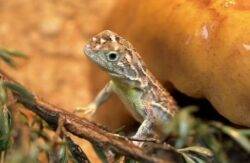The miniature Victorian grassland earless dragon has been rediscovered (Picture: Facebook/Zoos Victoria)
For more than 50 years, a small, earless dragon has been scurrying around the increasingly small area of grassland it calls home while humans thought it was extinct.
Until now.
The Victorian grassland earless dragon, which is only 15centimetres nose to tail when fully grown, has not been seen since 1969.
Once common across the native grasslands west of Melbourne, Australia, the miniature lizards were driven to the brink by habitat destruction and predation by animals including foxes and feral cats – which threaten other native species including Tasmanian devils.
Where the new population was discovered has not been revealed for the reptiles’ safety, but the Victorian state government, Australian federal government and Zoos Victoria released a statement pledging to work together to ensure the species’ recovery.
Work includes $188,000 for a project trialling the use of detection dogs to track down further populations of the dragon – in the UK dogs have been trained to sniff out great crested newts.
Zoos Victoria is also establishing a breeding programme to ensure the survival of the species – which will require removing some of the lizards from the wild and keeping them in captivity.
‘The extraordinary rediscovery of this critically endangered and cryptic lizard inspires optimism for the recovery of this Victorian species,’ said Zoos Victoria CEO Dr Jenny Gray.
The reptile is only found in the Australia state of Victoria (Picture: Facebook/Zoos Victoria)
‘Zoos Victoria is proud to be lending years of expertise honed through the breeding recovery programme at Melbourne Zoo for Canberra dragons.’
Tanya Plibersek, commonwealth minister for the environment and water, added: ‘I want to protect our precious creatures for our kids and grandkids. It’s such exciting news that the Victorian grassland earless dragon has been rediscovered. It’s a reminder about why it’s so important to invest in habitat restoration and the eradication of feral species like cats and foxes.
‘To best support the recovery of the Victorian grassland earless dragon, we have to know where they are. Detection dogs are an effective and non-invasive way to find this highly cryptic and critically endangered lizard in the wild.
The lowdown: Victorian grassland earless dragon
As the name suggests, the reptiles are found in Victorian grasslands and have no external ear openings or functional eardrums.
They are typically light brown in colour, with three thin white stripes running down their back and darker bands running across the body.
The dragons reach maturity within a few months and can reproduce the year they were born – but may only produce once in their lifetime.
During colder winters they enter torpor – a state of decreased physiological activity but not hibernation – but can remain active throughout the year in warmer conditions.
Source: Zoos Victoria
‘I’m so pleased to announce that the Federal Labor Government is investing $98,000 for this project to find populations of the rare dragons.’
A 2019 study concluded that 100 plant and animal species are thought to have gone extinct since the colonisation of Australia by Europeans around 230 years ago, including nine birds, four frogs and perhaps the most famous, the Tasmanian tiger, or Thylacine, a large carnivorous marsupial.
The last known individual died on September 7, 1936. Named Benjamin, it died of exposure after being locked out of its shelter overnight at Hobart Zoo.
MORE : Remains of the last Tasmanian tiger found in a cupboard after 85 years
MORE : Tasmanian devils born on Australian mainland for the first time in 3,000 years
But it’s very cute.





